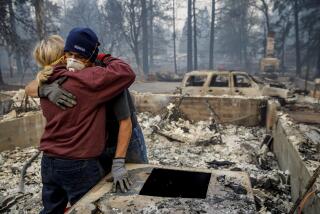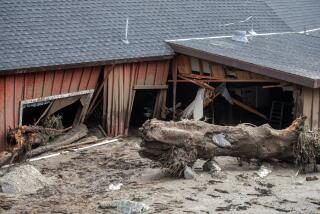Harbison Canyon still feeling the burn from the last fire
HARBISON CANYON, Calif. -- Last week, this community marked an important milestone when the local planning commission voted 15 to 0 to advance plans for a new fire station.
It would replace the one that burned to the ground four years ago along with 287 of the 388 homes, the town church, and a welding shop, a trailer dealership and the town tavern -- three of Harbison Canyon’s five commercial enterprises.
Tuesday afternoon, Mary Manning, the affable 53-year-old president of the local Lions Club, stared through the bay window of her 900-square-foot cottage -- “the smallest house in the canyon,” she called it, “with the biggest view.” She and her husband, Ed, have lived here, their lives framed by twin, sumac-covered peaks called Ironside and Chocolate Drop, for 30 years.
“We don’t believe,” she said quietly, her hands folded on her lap, “that God would do it again.”
But four years, almost to the day, after the Cedar fire laid waste to Harbison Canyon -- during a two-week firestorm that destroyed more than 3,500 homes and charred 750,000 acres in Southern California -- the town was in grave danger again.
To the north, the Witch fire raged near Blossom Valley. To the east and south, the Harris fire pushed toward Jamul. The air in Harbison Canyon, a community 25 miles east of San Diego, was clear, hot and still, but five distinct shafts of dark smoke billowed ominously over the ridgeline.
The rest of the world, by and large, had moved on from the Cedar blaze -- or certainly has by now, with a new series of firestorms erupting in startling fashion this week.
At first blush, it might seem that “Harbo,” as it’s known locally, had moved on too.
There are 1,300 people, give or take, who live in the town proper, roughly the same number as before Cedar. Horses frolick again outside small, frontyard stables. The town drunk, known as The Mayor, is still here.
There are giant new homes, most of them financed at least in part through insurance settlements; the newest addition is a resort-style log cabin with an eagle’s head carved into the second-story eave over the front door.
Beneath the surface, though, recovery remains the defining element of life in Harbison Canyon, more so than in any of the other communities hit during Cedar. And that makes the possibility of another strike unthinkable.
“Just the smell of that smoke -- on your clothes, in your hair -- it’s nauseating to everyone in this canyon,” Mary Manning said. “The memory. . . . “
Her voice trailed off.
It would be difficult to overstate the terror that seized Harbison Canyon last time. Amid shifting winds, the fire surged over the peak of Ironside and blew through the canyon like a bullet through the barrel of a gun. Though no one died, virtually no one escaped unscathed.
Manning has run a small day-care business out of her home since she moved to the unincorporated town, and, all told, has watched over about 125 children. Just one of the families she has worked with survived the fire without severe damage to its home; most homes were reduced to concrete slabs and stone fireplaces. Every home on the west side of Mountain View Road, the main road into town, was lost.
Harbo is not a place for the lily-livered. Bob Hopkins, 55, had sliced his hand open Tuesday removing a wind-felled walnut tree from his roof in anticipation of another fire, and had wrapped his gaping wound in duct tape. Hopkins, who grew up here, was one of a dozen or so residents who stayed behind last time to try to fend off the Cedar fire.
“It was rough. It was hot,” he said. “It was raining embers as big as your head. Propane tanks were blowing up. Houses were going up in two seconds.”
There are reminders of the Cedar fire everywhere.
Charred trees fill the landscape; several residents have nailed small signs showing their house number onto blackened, lifeless tree trunks along the streets.
The contorted, burned-out carcass of a pickup truck is still burrowed into the hillside above Harbison Canyon Road.
The vote advancing plans for the new fire station took place in a tiny civic center; outside, a swing set is still bowed in the middle from the heat of four years ago.
But the Cedar fire does not represent merely a signpost from the past. The fire poses, even today, a constant struggle.
There is just a single business, a small realty company, in what’s called -- with no hint of irony -- the “commercial district.” The town church hasn’t been rebuilt, nor has the bar, the Canyon Inn, which once served as a de facto town hall.
Plans for the fire station may be advancing, but there won’t be much to park inside; two of the town’s three firetrucks were lost during Cedar, and the remaining one, a 1987 open-cab engine, has been parked in front of the fire captain’s house since 2003.
The town center is back to about 340 homes, but that means about 50 others that burned down haven’t yet been replaced, many of them the subjects of epic insurance battles that make up a significant portion of the town chatter.
Nowhere was it more evident that Harbison Canyon isn’t ready for another fire than along Mountain View Road, where Bill Nielsen, 54, could be found tacking siding onto the walls of a home he’s still rebuilding -- even as smoke from the next fire puffed over the hills behind him.
Nielsen, an engineer, owned two houses here when the Cedar fire came. Both -- the one he lived in and this one, which he rented out -- were total losses. He’s doing a lot of the rebuilding himself. Meantime, he lived with his wife and two daughters in a 36-foot trailer -- for three years, until the first house was done.
“We haven’t had time to plant any shrubs or anything yet,” he said, glancing across the hardscrabble lot.
“Which is good, I guess, if there’s another fire.”
In important ways, residents say, Cedar marked a sea change for the little town.
There wasn’t much of anything in Harbison Canyon before the 1930s, just a smattering of cottages used as weekend getaways by wealthy families from San Diego. When the cottages fell into disrepair, they became cheap rentals. In the ‘60s, biker gangs moved in, and hard-core drug use soon followed.
The Cedar fire was seen by many residents as a cleansing, an event that swept out much of the old riffraff.
“It was a shanty town,” said Mike Bush, 32, a general contractor who lives on a 40-acre tract on the outskirts of Harbison Canyon. Now, he said, his two closest neighbors have listed their properties for $1.5 million and $1.2 million.
Before the Cedar fire, too, there was a live-and-let-live attitude, particularly concerning residents who allowed dry brush to build up on their property. Not anymore. A large, hand-painted sign was perched against a tree Tuesday: “No more brush!”
“Before, if someone had a lot of crud in their yard, everybody just figured that’s the way it is,” Ed Manning said.
“There was a big change when people realized their house burned down because of their neighbor’s crud.”
There’s a new image, a surge of civic pride. This time, they don’t want to let it go.
“We’re still redneck America. But we’re not a bunch of hicks,” Mary Manning said. “There’s a new kind of bond here. We’re activists now. We’re preservationists.
“But it’s been such a drain -- a financial drain and an emotional drain. I just don’t know if we could go through it a second time.”
More to Read
Start your day right
Sign up for Essential California for news, features and recommendations from the L.A. Times and beyond in your inbox six days a week.
You may occasionally receive promotional content from the Los Angeles Times.







